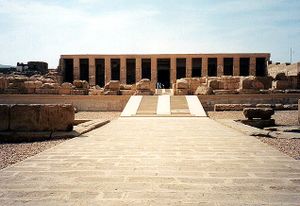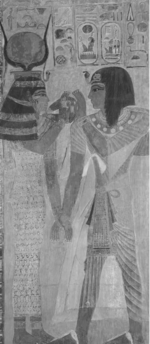Temple of Seti I Helicopter hieroglyphs: Difference between revisions
(Adding info about art) |
|||
| Line 11: | Line 11: | ||
===Temple of Seti I's Art=== | ===Temple of Seti I's Art=== | ||
Seti I had an interesting technique with the art around his temple. Mysliwiec noticed that there were two different types of styles Seti I used before and after his death. He believed that it corresponded to the earlier part of his reign when the chapel for his father, Ramesses I, was being decorated at Arybos and later in his life when he passed away and his son, Ramesses II, took over the construction and decoration. | Seti I had an interesting technique with the art around his temple. Mysliwiec noticed that there were two different types of styles Seti I used before and after his death. He believed that it corresponded to the earlier part of his reign when the chapel for his father, Ramesses I, was being decorated at Arybos and later in his life when he passed away and his son, Ramesses II, took over the construction and decoration. Once Ramesses II took over, he decided to change some of the writing his father put in the temple. | ||
Revision as of 17:41, 28 November 2017

The Temple of Seti I was constructed in memory of the 19th Dynasty and it was completed by his son, Ramesses II. Part of the plaster in the overhang has crumbled, revealing some interesting and unique hieroglyphics. They depicted strangely similar modern machines that caused eyebrows to raise wondering if Egyptians knew about modern technology.
Background
Pharaoh Seti I
Seti I was the son of Ramses I and Queen Sitre. He followed the footsteps of his father, which was to become a military man. While in the military, he earned multiple titles, like troop commander, vizier and head archer, and this made him to be considered a powerful man throughout Egypt. He reigned from 1291 to 1279 BCE. Since his father only reigned Egypt for 2 years, people claimed that Seti was the real founder of the greatness of the Ramessids. During his reign, he led his army northward to restore Egyptian prestige. He battled in northern Palestine and Syria, but ended it with a peace treaty that may have established the frontier at Kadesh on the Orontes River. Seti truly made Egypt prosper during his reign. He fortified the frontier, dug wells, open mines, rebuilt temples and shrines that have been falling apart, and continued the work of his father in completing the great hypostyle hall at Karnak, which is deemed to be the most magnificent monument in Egyptian architecture.

Temple of Seti I
The Temple of Seti I is located in Abydos, which is where many important and well-known pharaohs were buried. This temple is considered among the finest examples of ancient Egyptian art, also one of the largest memorial temples located along the edge of the floodplain to the south of Osiris’ Abydos temple. Seti I wanted his whole temple to be adorn with this type of Egyptian art, which was the largest in the Valley of the Kings at Thebes. This temple was not completed while Seti I was still alive. His son, Ramses II, who succeeded his father and became one of the greatest pharaohs of Ancient Egypt, completed Seti I's temple during his reign.
Temple of Seti I's Art
Seti I had an interesting technique with the art around his temple. Mysliwiec noticed that there were two different types of styles Seti I used before and after his death. He believed that it corresponded to the earlier part of his reign when the chapel for his father, Ramesses I, was being decorated at Arybos and later in his life when he passed away and his son, Ramesses II, took over the construction and decoration. Once Ramesses II took over, he decided to change some of the writing his father put in the temple.